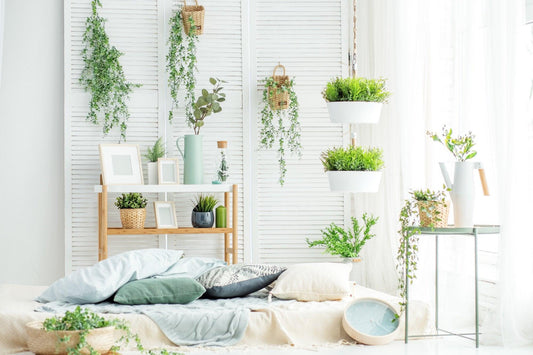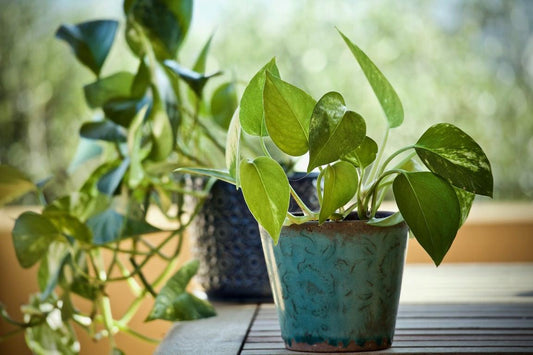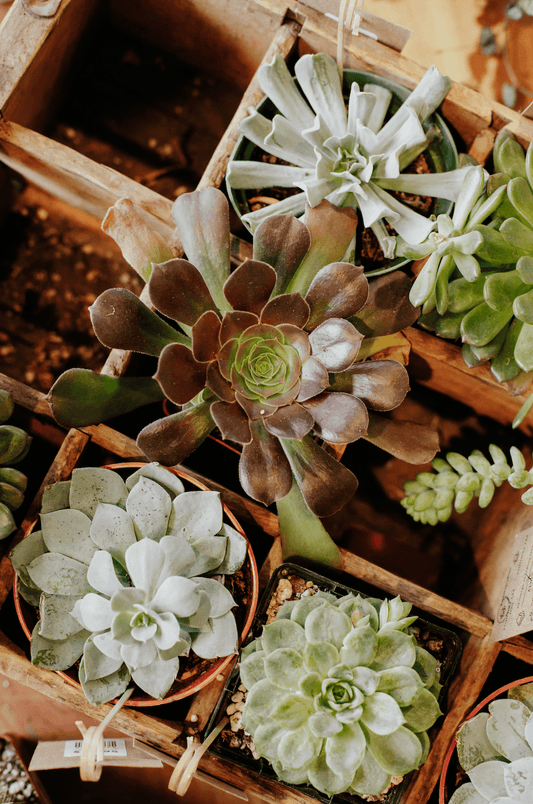66% of American households own at least one houseplant, and houseplant demand grew by 18% during the pandemic. Based on these statistics, it's likely that you have a few plants to spruce your place up.
Most people only utilize the existing space they have for plants, such as shelves, tables, and windowsills. But why not think further upward? Your ceiling is full of hangable space, so you can create a lush aesthetic by filling up that empty area.
Keep reading to see how to hang plants from a ceiling, so you create an indoor jungle in your home.
Things to Consider
Before you start drilling and hammering, you'll need to first scout out potential homes for your plants. And to do that, you need to consider each plant's needs.
For example, calatheas are fussy and require high temperatures and humidity, and prefer filtered light and shade. This means that hanging them in front of a drafty window would be a disaster. Instead, a better place for this delicate tropical plant is in the bathroom, where it'll receive filtered light through the skylight and plenty of humidity from your showers.
Knowing each plant's individual needs will enable you to pick optimal places to hang them in your home. As a result, you'll be able to fill your space in a way that's both visually pleasing and favorable for your houseplants.
Also, you'll need to decide what material you're screwing the hanging planters into. This will determine what equipment you'll need to secure your plants.
The hangers you choose may affect what equipment you use too. For instance, a sturdy ceramic container will need more heavy-duty hardware than a lighter terracotta pot.
Equipment You'll Need
The last thing you want is for your plants to come crashing down and surprising you with a hit on the head. Or worse yet, breaking the beautiful planter and its vines off too.
First, you'll need a stud finder. This will show you where you can drill and install hangers that are stable and sturdy.
You'll also need a pencil to mark spots, a drill, drill bits, screw hooks, and toggle bolts.
How to Install the Hooks
Get your stud finder out and use your pencil to mark where you want to drill holes. Then, select a drill bit that'll make holes that are slightly smaller than your hooks.
After drilling, you'll twist the screw hooks in to finish the job. These also work for ceiling joists.
If you aren't able to locate studs or ceiling joists, then you'll have to drill into drywall. In this case, use a drill bit that's the same size as the toggle bolt when it's shut.
Then, screw the toggle bolt onto the hook screws. Make sure it looks like a roof instead of a V before putting it into the hole. When the toggle bolt opens, pull down and screw the hook in.
Advice for Renters
If you're renting, then you'll be more limited in options. However, there are ways to get creative.
Here are some choices to hang plants up without losing your deposit.
Suction Cup Hooks
For tiny plants, you can use suction cup hooks. These are cheap, but most only hold up to 1 pound. However, you can find some that hold up to 20 pounds, although they'll be more expensive.
Not only are you limited by the weight, but also, you can only put suction cups on smooth and non-porous surfaces, such as glass or plastic. So it's likely you'll have to try some alternative methods below for your houseplants.
Adhesive Hooks
Adhesive hooks are another cheap way to hang plants. They can hold more weight than suction cups (up to 25 pounds) and you'll have more flexibility as to which surfaces you can attach them to.
The only issue is that if you stick the adhesive hooks directly on the ceiling, you probably won't be able to hook your hanging planter onto it. Instead, you should place the hooks at the very top of the wall so your houseplants appear to be they're hanging from the ceiling.
Magnetic Hooks
There are heavy-duty magnetic hooks you can put on your ceilings without drilling holes. Just find ceiling grids or roof trusses, and these will attach to support up to 9 pounds of weight.
You may want to spread the plant hanger weight out across several magnetic hooks to ensure stability.
Tension Rods
As the name suggests, tension rods work by driving force into two flat surfaces across from one another. They're mostly used for hanging curtains, so you can count on these easily holding your planters. Depending on the type you get, it can hold between 10 and 45 pounds.
Tension rods offer lots of flexibility; not only can you put them in front of your windows, but also any place where the rod fits.
While these don't actually hang your plants from the ceiling, they're high enough that it gives the illusion that they are.
C-Clamps
Do you live in a home with exposed ceiling beams? Then C-clamps will work excellently!
You won't have to worry about the C-clamps falling off, so long as you put them on correctly. The strongest ones can hold 40,000 pounds, so put the lushest plant up with confidence.
Options for Plant Hangers
Now that you know how to ensure your plants won't come crashing down from the ceiling, it's time for the fun stuff. Here are some choices you can consider to match your current interior decor and create good homes for your houseplants.
Mini Hanging Planter
If you're unsure about hanging plants, then it's ok to start small. A mini hanging planter is perfect for that small peperomia or fern that you've just propagated.
Consider getting our Mini Mofo hanging planter, which comes in two sizes: 5 or 7.5 inches. There are also the colors light gray, black, white, and blue-gray.
The matte clay pot has a contemporary geometric design that's simple yet interesting. Plus, it comes with a metal O-ring and waterproof rope so you can put your plants up in the air immediately after receiving your planter.
Hanging Basket
For something made of natural, more lightweight materials, look to hanging baskets instead. You can have one in the corner as an accent piece, or you can group several together to have the various vines tumbling into one another.
Our hanging baskets are made with manila hemp, which is handwoven with careful attention to detail. Each one is truly one-of-a-kind!
Round Hanging Planter
Your Hoya Hindu rope might already look stunning on its own, but you can make it a standout star by framing it in a round hanging planter. What's great about this hanger is that when it rotates slowly due to the room's airflow, you can get a good look at the plant from all angles.
Our rattan round hanging planter is an outstanding pick since it's handwoven and light. And if you've already got a boho vibe in your living room, it'll fit right in!
Hanging Tray
For versatility, you need to have a hanging tray or two. In one, you can place a large Monstera albo as a proud piece, and in another, you can group all your cute cuttings together.
As the seasons change, you can swap out the houseplants and try different groupings to play around with their effects.
Ladder Plant Hanger
If you've spotted a small ladder at the store, then bring it home. You can then either attach it to the ceiling with hooks and wires, or opt for thick twine for a more rustic look.
You can then install hooks between each rung on each side of the ladder, and hang it vertically. You can put up different houseplants at varying lengths to give it a fuller and more exciting esthetic. Vining plants are a great choice, as you can drape their vines across the ladder.
Another idea is to hang small globes with air plants like tillandsia in them. You don't have to water them often either.
Know How to Hang Plants From a Ceiling for Fantastic Results
By knowing how to hang plants from a ceiling, you can take advantage of the vertical space in your house.
This is outstanding news for plant enthusiasts, as you can grow your collection even further! And even better is, you can still hang your houseplants in a rented property through some innovative and affordable ways.
If you'd like more types of plants to hang, then check out our selection now.




